How to Raise Restaurant Prices Without Losing Customers

The restaurant industry is facing an unavoidable challenge: food inflation is skyrocketing, labor costs are rising, and profit margins are shrinking. Restaurant owners must find ways to raise menu prices without alienating customers or hurting sales.
The truth is, raising prices doesn’t have to drive customers away — if done strategically. This guide will show you how to calculate price increases, leverage menu engineering, use psychological pricing tricks, and communicate changes effectively to keep diners happy and your bottom line healthy.
Let’s break it all down.
Why Are Restaurant Prices Increasing? Understanding the Market Forces
If you’re feeling pressure to raise menu prices, you’re not alone. Food inflation hit a record high in 2022 and remains volatile in 2025.
Key Statistics on Restaurant Costs:
Food Costs:
- In 2024, average wholesale food prices increased by 7.0% compared to the previous year.
- In 2025, overall food prices are anticipated to rise by 2.2%, with food-away-from-home prices (i.e., restaurant prices) expected to increase by 3.6%.
Labor Costs:
- In 2024, 88% of restaurant operators reported an increase in labor costs:
- 51% experienced a 1-5% increase.
- 41% saw a 6-14% increase.
- 8% reported an increase of more than 15%.
- Looking ahead, 89% of operators expect labor costs to continue rising in 2025.
Profit Margins:
- The average profit margin for full-service restaurants was reported at 9.8% in 2024.
- In 2024, 38% of restaurants reported being unprofitable in the previous year.
Menu Price Increases:
- In 2024, 47% of restaurants increased their menu prices.
- For 2025, 57% of restaurant operators expect to raise menu prices, a decrease from 71% in the previous year.
Translation? If you don't adjust menu prices properly, you're losing money.
How to Calculate Restaurant Price Increases Without Losing Customers
Before raising prices, you need to analyze the numbers. Follow these three pricing formulas:
1. Food Cost Percentage
Your target food cost percentage should be 28-35% of the menu price.
Formula:

Example:
- Your burger costs $5 to make and sells for $15.
- Food cost % = (5/15) x 100 = 33%
- If the cost rises to $6, adjust the price to $17-18 to maintain the margin.
2. Prime Cost Calculation
Prime Cost = Food Costs + Labor Costs
Ideal Prime Cost should be 55-60% of total sales.
Example:
- Food Cost: $12,000/month
- Labor Cost: $15,000/month
- Prime Cost = $27,000
- If monthly sales are $50,000, your prime cost is 54% (Healthy Range)
- If your prime cost jumps to 65%, you need to raise prices or cut costs.
3. Contribution Margin (CM)
CM per dish = Menu Price - Food Cost
High contribution margin dishes should be promoted the most.
Example:
- A pasta dish costs $3.50 to make and sells for $16
- CM = $16 - $3.50 = $12.50
- If ingredient costs rise, you must adjust prices or find cost-effective ingredient swaps.
Menu Engineering: The Secret Weapon to Keep Customers Happy & Profits High
Menu engineering is more than just designing an attractive menu — it’s a strategic approach to maximizing restaurant profits while keeping customers satisfied. Thoughtful menu optimization can subtly guide diners toward high-margin items, enhance their dining experience, and even mitigate the impact of rising food costs. The next part of this article will break down the key menu engineering techniques that drive profitability without compromising quality.
Optimize Menu Layout for Maximum Profitability
The way a menu is structured directly influences customer choices. Studies in menu psychology show that diners follow predictable eye movement patterns, meaning that strategic placement of items can boost sales.
Where to Position Best-Selling and High-Profit Dishes:
- Upper Right Corner: This is where customers’ eyes naturally land first. Featuring best-selling dishes in this prime real estate ensures they receive maximum visibility.
- Highlight High-Profit Items: Using subtle design techniques — such as boxes, icons, or different typography — can make high-margin dishes stand out. These visual cues direct customer attention without feeling like a sales tactic.
- Remove Dollar Signs ($): Research indicates that eliminating the dollar sign reduces price sensitivity. Diners perceive prices less like a transaction and more like an inherent value, making them more likely to order premium dishes.

Shrink Portions Strategically Instead of Raising Prices
Inflation and fluctuating ingredient costs put pressure on restaurant margins. Instead of simply increasing prices — risking customer pushback — restaurants can adjust portion sizes strategically while maintaining perceived value.
Example of Smart Portion Adjustments:
- Reduce a 12-ounce steak to 10 ounces while keeping the same price. The difference is subtle enough that most customers won’t notice.
- Complement smaller portions with low-cost, high-value fillers like fresh bread, side salads, or garnishes to maintain a satisfying plate presentation.
By making these incremental adjustments, restaurants can protect margins while ensuring diners still feel they’re getting a great value.
Swap Expensive Ingredients to Reduce Costs Without Sacrificing Quality
Ingredient costs fluctuate, and restaurants need to be agile in their sourcing. Swapping out expensive ingredients for cost-effective alternatives can significantly impact food costs while maintaining dish integrity.
Practical Ingredient Substitutions:
- Use seasonal produce: Buying in-season fruits and vegetables prevents paying premium prices for out-of-season items.
- Swap imported cheeses for local varieties: Many local cheeses have similar textures and flavor profiles to their imported counterparts at a lower cost.
- Experiment with alternative proteins: Instead of pricier meats like filet mignon, consider using flavorful, well-prepared cuts such as hanger steak or short ribs.
These smart swaps not only save money but also allow restaurants to promote local and sustainable sourcing, which resonates with customers.
How to Communicate Price Increases Without Losing Customers
Rising food costs, labor wages, and supply chain disruptions make occasional price increases unavoidable. However, how a restaurant communicates these changes can determine whether customers remain loyal or feel alienated.
Train Staff to Handle Price Objections Confidently
Frontline staff often bear the brunt of customer reactions to price increases. Proper training can equip them with the right responses to reassure guests that higher prices come with added value.
Example Customer Interaction:
- Customer: “Wow, your burgers are $18 now?”
- Server Response: “Yes! We now use 100% grass-fed beef from a local farm, so you’re getting even better quality. We’re committed to serving the best ingredients, and we appreciate your support.”
This response emphasizes the why behind the price change, shifting the focus from cost to quality.

Use Social Media to Announce Menu Adjustments Transparently
Restaurants can control the narrative around price increases by using their digital presence to communicate the value behind changes.
Example Social Media Post:
"We’re committed to bringing you the freshest, highest-quality ingredients. To continue doing so, we’ve made slight adjustments to our menu prices. We appreciate your continued support in helping us serve you the best food possible. Thank you for supporting local restaurants!"
By framing price increases as a commitment to quality and sustainability, restaurants can turn potential backlash into an opportunity to strengthen customer relationships.
Offer Limited-Time Deals to Smooth the Transition
To ease customers into price changes, consider offering short-term promotions that reinforce loyalty.
Examples of Transition Incentives:
- “New Menu, New Rewards!”: Offer a free appetizer or dessert for returning customers who try updated menu items.
- Loyalty Program Perks: Introduce discounts or rewards for repeat diners.
- Combo Deals: Bundle popular dishes at an adjusted price to maintain perceived value.
These small incentives can help customers feel valued while subtly acclimating them to new pricing structures.
Advanced Pricing Strategies for Online & Delivery Orders
The rise of online ordering has reshaped pricing strategies for restaurants. Customers expect higher delivery prices due to service fees, but restaurants can still optimize their pricing structure to maximize profits without discouraging orders.
Adjust Prices for Delivery to Offset Third-Party Fees
Delivery platforms like Uber Eats, DoorDash, and Grubhub charge commissions ranging from 10-30% per order. To maintain margins, restaurants should implement tiered pricing strategies.
Best Practices for Delivery Pricing:
- Increase delivery menu prices by 10-15% to compensate for commission fees.
- Offer exclusive direct ordering discounts: Encourage customers to order from the restaurant’s own website with incentives like “Save 10% when ordering directly with us.”
- Create exclusive online-only menu bundles: Offering combo deals for digital customers helps justify adjusted prices while creating value.
Leverage Online-Only Deals to Drive Direct Orders
Reducing reliance on third-party platforms can significantly improve profit margins. Encouraging customers to order directly helps bypass hefty commission fees.
Effective Digital Ordering Incentives:
- “Order Direct & Save” Promotions: Offer a discount or free item when customers use the restaurant’s website instead of third-party apps.
- Loyalty Points for Online Orders: Reward repeat customers who place direct orders with future discounts or freebies.
- Exclusive Digital Menu Items: Feature special dishes only available for direct orders to incentivize platform usage.
By making direct ordering more attractive, restaurants can reduce third-party fees while fostering stronger customer relationships.
Final Thoughts: Smart Menu Strategies Keep Profits High and Customers Happy
Menu engineering is a powerful yet often overlooked tool for increasing restaurant profitability. By optimizing menu layouts, strategically adjusting portion sizes, swapping costly ingredients, and implementing smart pricing strategies, restaurants can maintain healthy margins without alienating customers.
Key Takeaways:
- Use psychology-driven menu design to highlight profitable items.
- Shrink portions subtly instead of raising prices outright.
- Replace expensive ingredients with cost-effective, high-quality alternatives.
- Communicate price increases transparently through staff training and social media.
- Optimize digital pricing strategies to maximize online and delivery profits.
By applying these menu engineering tactics, restaurants can navigate industry challenges while delivering an exceptional dining experience.
For restaurant owners who want to lower operating costs and increase margins, invest in a people management system like Push. With one-click payroll, facial recognition clock-ins that prevent buddy punching, and labor vs. sales forecasting, Push is the secret ingredient your restaurant needs to optimize labor and lower overhead. Schedule a free demo today!



